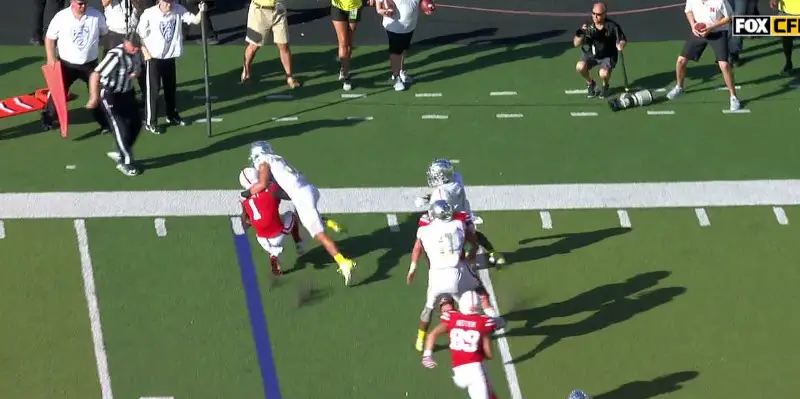Setting the edge and limiting runs in the wide open spaces is the first thing coaches must establish in an effective defense. It happens when the end man on the line of scrimmage, usually a defensive end or an outside linebacker, crosses the line of scrimmage, digs his feet in, lowers his inside shoulder to keep outside leverage, and fights off a block coming from a running back or offensive lineman (in a rare case, a defensive back could be responsible if the front seven was massed to stop a running play in short yardage or goal line situations). Setting the edge is no job for the timid.
Last season, the Ducks were inconsistent in setting the edge and it resulted in many long gains for opponents. So far this year, it’s a been a big turnaround. The defender responsible for the edge is holding his position and turning outside running plays back into where his defensive buddies are coming in hot pursuit.
In this example above, the defensive end (DE) drifts a bit outside with his shoulders turned inside (don’t get hooked!), but still establishes the edge. He’s strong enough to fight the block and make the runner turn inside. The next defender inside is the defensive tackle (DT), and although a bit high with his pad level, he beats the offensive tackle (OT) and establishes himself in the C gap (between TE and OT) along with the DE, turning the play inside. (For an explanation of defensive gaps–click here)
The undersized Mike linebacker reacts quickly and attacks the B gap and makes the tackle. Notice how Oregon’s right DT gets a piece of the Nebraska OT who is releasing to block the linebacker (#35). By slowing the OT down just a bit, it keeps the linebacker free of the block and able to assist at the point of attack. The safety (#21) is also coming up in run support. In a 3-4 defense one of the defensive line’s main jobs is to keep blockers off the linebackers so they can get all the glory (i.e., tackles). Nobody notices this during the game except for the lineman’s immediate family. This is also as example of very well-coached defensive football.
On this play above, the defensive end (11) tightens down on a good angle and is in a good football position, prepared to take on the block of the pulling lineman. He contacts the offensive lineman and drives him backwards, allowing him to shuck the blocker and run down the ball carrier. More importantly, the inside linebacker and defensive back are sprinting for a cutoff point the defensive end helped establish with his reaction. All three defenders come with speed and good angles—excellent teamwork by three defenders setting and protecting the edge. You didn’t see this last season!
Watch Wyoming’s approach to running the football. The Ducks not only have to establish that edge for run defense but also for rushing the passer. If they lose the edge, they allow a great quarterback the opportunity of getting away from the rush, and offering scrambling opportunities against a secondary that will be chasing Cowboy receivers all over the field.
On the offensive side, look for this play (above) in a passing situation. In the left slot Charles Nelson, pauses on his release to give his tight end (TE) time to cross the field in front of him at about 10 yards deep. The Cornhuskers are in man coverage and Nelson makes his cut right in front of the tight end and the defender who is running with the TE. The defensive back covering Nelson has to avoid the tight end and the man covering him, as well as the umpire, who is situated behind the line of scrimmage. As Nelson makes the cut, he effectively “rubs” off his defender, who has to slow just a bit to avoid a collision.
Smart passing teams run this play all the time and usually line the depth of the route by the depth of the umpire, who provides a legal impediment (umpires are usually told to step up when the quarterback drops back to pass and if they did that, it would not be such an advantage for the offense).
Quarterback Justin Herbert‘s faulty footwork wrecks this play that would have yielded an important first down. Watch his feet and body—he is throwing with his lead foot (right) moving laterally and throwing across his body. This will cause him to throw the ball behind the receiver, which is what happened. Behind perfect protection Herbert should have stepped in the pocket with his lead foot at Nelson and thrown a completion to the Ducks’ most dynamic receiver, who was wide open.
This play is so basic you should look for it in situations where the Cowboys are playing man-to-man defense. If it’s zone, that’s okay for the Ducks– Nelson will just slow down in the area between defenders and show his numbers to Herbert.
Coach Ken Woody
Eugene, Oregon
Ken Woody is a former Fox Sports football commentator who played defensive back, receiver and kicker for Oregon from 1966 to 1970. He coached college football for 18 years, including stints as an assistant coach at Oregon, Washington, Washington State and Utah State, and was head coach at Whitman College and Washington University-St. Louis.
Top Photo from Video
Buy the book to learn from Coach Woody, or give a gift of football.
“Every Oregon fan should have a copy to learn from as I do.” Charles Fischer
Related Articles:
Seven Offensive Coordinator Candidates for the Oregon Ducks
Five Candidates to Replace OC Marcus Arroyo
Coach Jim Mastro: The Perception, and the Truth
Has Oregon Turned the Corner on Offense?
Ducks, Taggart Punish Beavers; Earn Bowling Trip
Textbook Defense, Herbert's Return Energize Duck Victory; Civil War Next
“I learned football working under many great coaches, among them Len Casanova, Jerry Frei, John Robinson, Bruce Snyder, George Seifert,and Ron Stratten at the University of Oregon, Jim Owens at the University of Washington and Jim Walden at Washington State University. Most of my coaching experience was on the offensive side of the ball with quarterbacks, receivers and kickers although as a head coach I coached defensive backs, linebackers and offensive line.
I achieved my first goal of being the youngest head coach in college football at the age of 26 and throughout my career in coaching and outside of it, as a journalist and broadcaster, have experienced how exciting and gratifying it is teaching the game to others.”

